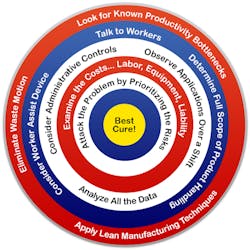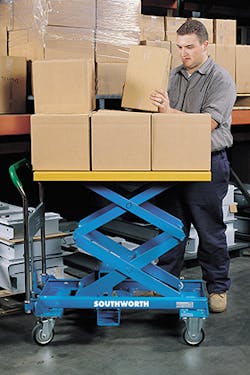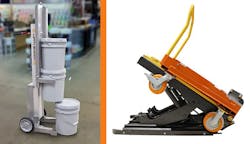Ergonomics Check-Up: Solve Ergonomic Issues With a Holistic Approach
It’s easy to settle for the quick fix when a painful situation arises. Facility managers should resist this temptation when they notice injury trends in the workplace, says Jim Galante, director of business development at Southworth Products Corp, a maker of ergonomic material handling equipment.
“They want to do something quickly to show the employees that they’re making progress,” Galante says. “There’s the old argument that even though I didn’t fix 100% of the problem, if I fix 30% of it, it’s 30% better than it was. That’s like cutting back from two packs of cigarettes a day to a pack-and-half because it’ll be 30% better for your health.”
But, partial quick-fix ergonomic solutions are not adequate for today’s material handling workforce. Many companies today are heavily reliant on aging workers, who may have difficulty keeping pace with physical demands if managers don’t take a holistic approach to improving the workplace.
Facility leaders must fully diagnose an injury problem before implementing a solution to prevent future problems, Galante says. The process begins with an assessment of known productivity bottlenecks. Then, talk to workers and observe how they use applications in their natural environment. Other key parts of the process include examining the associated costs and prioritizing risks (see Figure 1).
After they’ve examined each step in the process and all the potential factors, managers should implement comprehensive material handling solutions that address injuries on multiple fronts, he says. This may include lean manufacturing practices and the elimination of wasted motion, Galante says.
Set Your Sights on the Root Cause to Find the Best Cure
For example, managers may see a worker struggling to push a cart and conclude it’s a problem with the wheels. “One of the things managers tend to do, especially those not in the health and safety community, is to pick the low-hanging fruit and fix that problem,” Galante says.
But oftentimes the root cause of injuries involves several factors. Managers should observe workers in their work environment to identify each potential source of stress, Galante says. If workers are repeatedly picking up boxes from a pallet or the floor to load them onto carts or conveyors, it could be a sign they need carts with lifting or tilting capabilities. Also check to see whether workers are reaching out or across the cart. This can place additional stress on their body.
“An ergonomist will tell you reaching out is worse than back bending,” Galante says. “Reaching out from the body, like across a cart, is going to put more stress on the lower back than picking something up from the floor.”
The load should be close enough to the worker that he or she doesn’t have to reach. For infrequent loads, the distance should be a maximum of 12 to 24 inches, measured from the spine. In addition, vertical cart handles should be no more than 18 to 20 inches apart, and horizontal handles should be positioned between 36 and 45 inches from the floor, according to Galante. This helps ensure that workers are using correct posture when pushing the cart.
Stacking capabilities are also critical for many applications. Workers may need a cart that can stack pails, barrels or other cylindrical-shaped containers. Galante recalls observing a worker manually lifting 5-gallon latex paint pails from a cart.
“I was glad to see she was using a four-wheel cart rather than trying to carry those heavy pails, but it quickly became obvious that transport was only part of the problem,” he says. “All that lifting of heavy pails is a major stressor, and over the course of a shift that same employee might lift dozens of pails.”
Carts with lifting capabilities can pick a pail off of the floor or a pallet and then raise it up to place it on a counter or shelf with no manual handling.
Focus on Long-Term Savings
After facility managers determine the appropriate solutions, they should apply them consistently throughout the operations, Galante says. Organizations often hesitate to address all of the potential issues because they’re concerned about the upfront cost. But delaying ergonomic upgrades or implementing only partial solutions can have major implications on long-term workers’ compensation costs.
Workers’ compensation underwriters monitor trends over a period of time before lowering their premiums. This means organizations must prove their solutions are working. A single adjustment won’t result in immediate savings, Galante says.
“It might take a few years because it’s based on history,” he says. “If you have a high incident rate of back injuries, the premiums are not going to drop until incidents drop.”
One New Jersey grocery company reduced its workers’ compensation costs to $300,000 from $1.1 million over a three-year period by implementing a series of complete comprehensive ergonomic solutions, Galante says. “The equipment helped workers eliminate manual material handling problems,” he says.
The company made a one-time investment of less than $200,000 for ergonomic equipment but can expect more than $800,000 in savings annually, Galante says.
Heal Workforce Wounds
The benefits of proper ergonomic interventions go beyond cost savings. Aging workers who may lack the agility they had decades earlier can perform their jobs much more efficiently and safely. In turn, productivity and workforce satisfaction increases significantly, as well.
In addition, finding more workers or replacing retirees has become much more challenging. This means companies must find solutions that make their existing workforce more productive and satisfied to increase retention rates.
“Protecting the employees you have today is far more important than in the past,” Galante says.
Job satisfaction and making people physically comfortable with their job helps retain them and makes it easier to introduce new employees to the manual material handling tasks that must be done, Galante says.
For more information, visit www.southworthproducts.com.
About the Author

Jonathan Katz
Freelance Editor and Writer
Jonathan Katz, owner of JSK Communications, is a freelance writer with more than 15 years of experience in the publishing industry. He is the former managing editor for Cannabis Business Times and Cannabis Dispensary at GIE Media and a former managing editor of IndustryWeek magazine at Endeavor Business Media.
At IW, Katz covered a wide range of manufacturing topics, including automation, safety, facilities/plant operations and executive leadership.
Prior to freelancing, Katz served as a project manager for Content4Demand, a content marketing agency.




